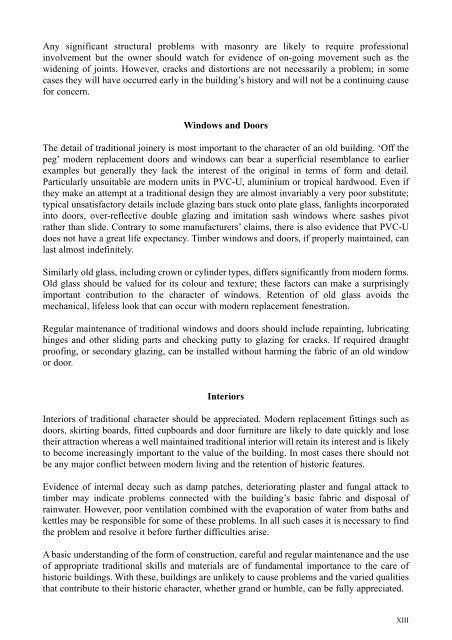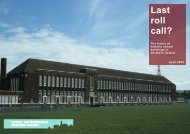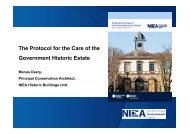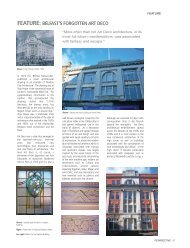Directory of Traditional Building Skills - Mourne Heritage Trust
Directory of Traditional Building Skills - Mourne Heritage Trust
Directory of Traditional Building Skills - Mourne Heritage Trust
Create successful ePaper yourself
Turn your PDF publications into a flip-book with our unique Google optimized e-Paper software.
Any significant structural problems with masonry are likely to require pr<strong>of</strong>essionalinvolvement but the owner should watch for evidence <strong>of</strong> on-going movement such as thewidening <strong>of</strong> joints. However, cracks and distortions are not necessarily a problem; in somecases they will have occurred early in the building’s history and will not be a continuing causefor concern.Windows and DoorsThe detail <strong>of</strong> traditional joinery is most important to the character <strong>of</strong> an old building. ‘Off thepeg’ modern replacement doors and windows can bear a superficial resemblance to earlierexamples but generally they lack the interest <strong>of</strong> the original in terms <strong>of</strong> form and detail.Particularly unsuitable are modern units in PVC-U, aluminium or tropical hardwood. Even ifthey make an attempt at a traditional design they are almost invariably a very poor substitute;typical unsatisfactory details include glazing bars stuck onto plate glass, fanlights incorporatedinto doors, over-reflective double glazing and imitation sash windows where sashes pivotrather than slide. Contrary to some manufacturers’ claims, there is also evidence that PVC-Udoes not have a great life expectancy. Timber windows and doors, if properly maintained, canlast almost indefinitely.Similarly old glass, including crown or cylinder types, differs significantly from modern forms.Old glass should be valued for its colour and texture; these factors can make a surprisinglyimportant contribution to the character <strong>of</strong> windows. Retention <strong>of</strong> old glass avoids themechanical, lifeless look that can occur with modern replacement fenestration.Regular maintenance <strong>of</strong> traditional windows and doors should include repainting, lubricatinghinges and other sliding parts and checking putty to glazing for cracks. If required draughtpro<strong>of</strong>ing, or secondary glazing, can be installed without harming the fabric <strong>of</strong> an old windowor door.InteriorsInteriors <strong>of</strong> traditional character should be appreciated. Modern replacement fittings such asdoors, skirting boards, fitted cupboards and door furniture are likely to date quickly and losetheir attraction whereas a well maintained traditional interior will retain its interest and is likelyto become increasingly important to the value <strong>of</strong> the building. In most cases there should notbe any major conflict between modern living and the retention <strong>of</strong> historic features.Evidence <strong>of</strong> internal decay such as damp patches, deteriorating plaster and fungal attack totimber may indicate problems connected with the building’s basic fabric and disposal <strong>of</strong>rainwater. However, poor ventilation combined with the evaporation <strong>of</strong> water from baths andkettles may be responsible for some <strong>of</strong> these problems. In all such cases it is necessary to findthe problem and resolve it before further difficulties arise.A basic understanding <strong>of</strong> the form <strong>of</strong> construction, careful and regular maintenance and the use<strong>of</strong> appropriate traditional skills and materials are <strong>of</strong> fundamental importance to the care <strong>of</strong>historic buildings. With these, buildings are unlikely to cause problems and the varied qualitiesthat contribute to their historic character, whether grand or humble, can be fully appreciated.XIII











